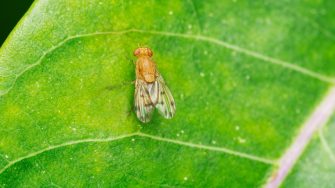Ask an Expert: How flapping insect wings can make new “micro drones” a reality
Unlocking the secrets of insect flight to revolutionise drone technology
Unlocking the secrets of insect flight to revolutionise drone technology

From the remarkable flight of the bumble bee, which challenges traditional aerodynamic theories, to the intricate wing structures of various insects, there is much to be learned from these tiny creatures; especially when it comes to the development of next generation “micro drones”. And with worldwide bee populations under threat, this new technology could even lead to the artificial pollination of plants using 'robobees'.
Dr Shantanu Bhat of UNSW Canberra’s School of Engineering is at the forefront of this exciting research, investigating the aerodynamics of insect wings to identify the most efficient designs for enhancing drone flight capabilities.
Paradoxes usually fascinate us as they showcase seemingly impossible things being possible. When we look closely at a bumblebee, we notice that it has a large body and relatively short, stubby wings. This makes us wonder how those small wings can generate enough upward force, also called 'lift', to support the insect’s weight. Traditional aerodynamic theory, developed for large aircraft in the early 20th century, implies that flying requires long, thin wings similar to large birds. According to this theory, a bumblebee shouldn’t be able to fly with its small wings. But bumblebees do fly, creating what’s known as the bumblebee paradox.
Basically, we learn that the same theory does not apply to flyers of all sizes. As the size decreases, the ability of a flyer to maintain its stable position or continuous motion also decreases. In physics, we call it ‘inertia’. For instance, try balancing a long vertically held stick on your open palm, which won’t be too difficult. But if you try to do the same with a pen, you will find that task to be nearly impossible. The smaller objects are difficult to stabilise. Similarly, flyers with lower inertia are highly unstable. Hence, with a change in size, the flying mechanism should also change.
Notice that airplanes can fly with steady wings; birds need to occasionally flap their wings; and insects need to continuously flap their wings extremely fast, at the rate of hundreds of strokes in a second. The same logic applies when we design drones.
Larger drones like quadcopters can fly with propellers. However, miniature drones can't be stabilised with those propellers. They will need a flapping-wing mechanism like in insects.
Miniature drones are small robotic flyers measuring a few centimetres or even smaller. Like insects, miniature drones experience highly unstable flight due to their negligible inertia, requiring a mechanism to generate extra lift for stability. Birds usually flap their wings up and down at a slower rate than insects. They generate an upward force or lift during the downward stroke only. The upstroke does not contribute to the lift generation.
However, miniature flyers require continuous generation of lift to stabilise their flight. Insects achieve this by employing quite peculiar and different flapping motions. They flap their wings forward and backward, maintaining a constant wing angle. During every half-stroke the wings push air downward, generating lift.
At the end of every forward or backward half-stroke, the wings flip and face backward such that they are able to generate lift in both half-strokes. By drawing inspiration from insects, we can equip miniature drones with insect-like flapping wings for their efficient and stable flight.
It's an interesting question without a single answer. Note that larger drones require larger wings and smaller drones require smaller wings to generate the lift proportional to their weights. The wing shapes are generally characterised by the ratio of their length to chord, known as the aspect ratio. In my research, I found that the aspect ratio that works the best for a smaller drone is not the best for a larger drone.
I studied different wing shapes created by modifying a fruit-fly wing as a reference and varied their size and aspect ratio. I measured their performance in terms of the lift coefficient and flight efficiency.
Interestingly, at a small size, aspect ratios between 2 and 3 performed best, while at larger sizes, aspect ratios between 2 and 5 were optimal.
Nature also reflects a similar diversity in wing shapes: smaller insects like fruit flies have short, stubby wings, i.e. only small aspect ratios, whereas larger insects like mosquitoes, honey bees, and dragonflies exhibit a wider range of aspect ratios from stubby to long and slender wings. Additionally, the actual wing shapes are influenced by other factors like structural strength, body length, and evolutionary considerations.
Certainly. Although the flapping motion is extremely power-consuming, it is useful in applications where low-inertia flight is necessary. In fact, it is impossible to fly miniature drones with fixed wings as I mentioned above.
These drones are useful in surveillance, weather monitoring, and even agriculture.
To address the challenges posed by the declining bee population, the possibility of artificial pollination using 'robobees' is being explored.
Additionally, a flapping-wing drone might be useful for flying in low-density atmospheres, like on Mars, to explore the Martian surface.